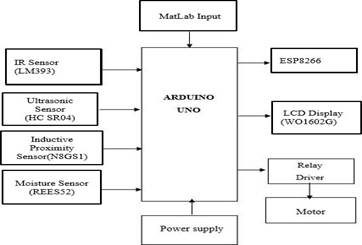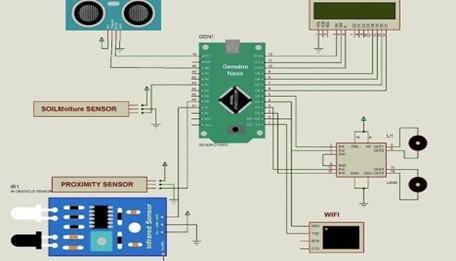Waste accumulation is one of the most pressing environmental challenges today. With the global population on the rise, massive volumes of garbage are generated daily—over 1,50,000 metric tons per day in India alone. Often, waste of various types is dumped together, making segregation difficult and inefficient. Traditional manual collection methods are prone to delays and inconsistent segregation, leading to unhygienic conditions and uncontrolled microbial growth. This project presents an IoT-enabled automatic waste segregation and monitoring system that classifies waste into wet, dry, and metallic categories using a combination of IR, ultrasonic, inductive proximity, and soil moisture sensors. An Arduino microcontroller, integrated with a Wi-Fi module, processes sensor data and controls servo motors for sorting. The system also monitors bin fill levels in real time and transmits data to a cloud server for remote viewing, eliminating the need for manual checks.
Manual waste segregation methods remain inefficient and inconsistent, especially at the household level. Most waste is collected without proper separation, making recycling difficult and increasing the risk of environmental pollution. Hazardous waste often ends up in landfills or natural ecosystems, contaminating soil, air, and water. The proposed IoT-based solution addresses these issues by automatically detecting and categorizing waste using sensors, ensuring accurate separation at the source. The system operates without human intervention, increasing the potential for material recovery and reuse.
System Overview
The setup is centered on an Arduino UNO microcontroller that coordinates the input from multiple sensors:
- IR Sensor: Detects the presence of waste.
- Moisture Sensor: Differentiates between wet and dry waste based on moisture content.
- Inductive Proximity Sensor: Detects metallic objects.
- Ultrasonic Sensor: Measures bin fill levels.
Based on sensor readings, the Arduino activates servo motors to position the correct collection bin beneath the waste inlet. A relay driver controls motor power, while an LCD display provides real-time system status. An ESP8266 Wi-Fi module enables cloud connectivity for data logging and remote monitoring.

List of Components Used
- Arduino UNO (ATmega328P microcontroller)
- ESP8266 Wi-Fi module
- Infrared (IR) sensor
- Moisture sensor (capacitive or resistive type)
- Inductive proximity sensor (metal detector)
- Ultrasonic sensor (HC-SR04 or equivalent)
- Servo motors (for bin rotation and flap control)
- Relay driver module
- LCD display (16×2 with or without I2C interface)
- External DC power adapter (suitable for servo motors)
- Connecting wires and jumper cables
- Breadboard or PCB for connections
- Waste collection bins (Dry, Wet, Metal)
- Mounting hardware (frames, brackets)
Circuit Design
The circuit integrates the sensors, microcontroller, actuators, and communication module. The IR sensor triggers the sorting process, the moisture sensor sends analog signals to identify wet waste, and the inductive sensor flags metallic waste. Signals are fed into designated Arduino pins, where programmed logic determines the waste category. Servo motors then move the bin selector mechanism. The ESP8266 connects to an IoT platform, such as ThingSpeak, to upload fill-level data. Power is supplied from an external adapter to meet the servo motor’s current demands.

Working Principle
When waste is deposited, the IR sensor detects its presence and triggers analysis. If the inductive sensor detects metal, the system directs it to the metal bin. If not metallic, the moisture sensor checks for high moisture content to identify wet waste; otherwise, it classifies as dry. Servo motors rotate the bin platform and open the inlet flap for deposition. Simultaneously, the ultrasonic sensor measures fill levels and sends this data via the IoT module to the cloud. Authorities can then monitor bin status remotely.
Implementation
Hardware Implementation:
- Define operational requirements and select sensor placement for optimal detection accuracy.
- Use compatible sensors with sufficient durability and low power consumption.
- Integrate Arduino UNO with ESP8266 for Wi-Fi connectivity.
- Connect servo motors to a dedicated power source to ensure stable operation.
Software Implementation:
- Programmed in Embedded C using Arduino IDE.
- Include libraries for each hardware component.
- Establish communication between the Arduino and ThingSpeak for data visualization.
- Implement secure data transmission via MQTT or HTTP protocols.
- Configure dashboards for real-time monitoring and alerts.
IoT Integration
ThingSpeak is used to visualize and analyze sensor data in real time. The platform provides APIs for seamless Arduino-ESP8266 communication. Graphical representations of bin fill levels and waste type statistics can be accessed via web or mobile interfaces. Data triggers can be set to notify authorities when bins reach capacity.
Advantages
- Eliminates manual segregation effort at the primary stage.
- Improves recycling rates by ensuring accurate separation.
- Real-time monitoring reduces unnecessary collection trips.
- Cost-effective and scalable for municipal or community use.
- Reduces landfill waste and supports sustainability goals.
Conclusion
The IoT-based Automatic Waste Segregation and Monitoring System is an innovative approach to modern waste management challenges. By combining precise sensor technology with IoT capabilities, it enables accurate waste classification, real-time monitoring, and optimized resource allocation. The system’s scalability and adaptability make it suitable for urban deployment, supporting the transition towards smart, sustainable cities.
